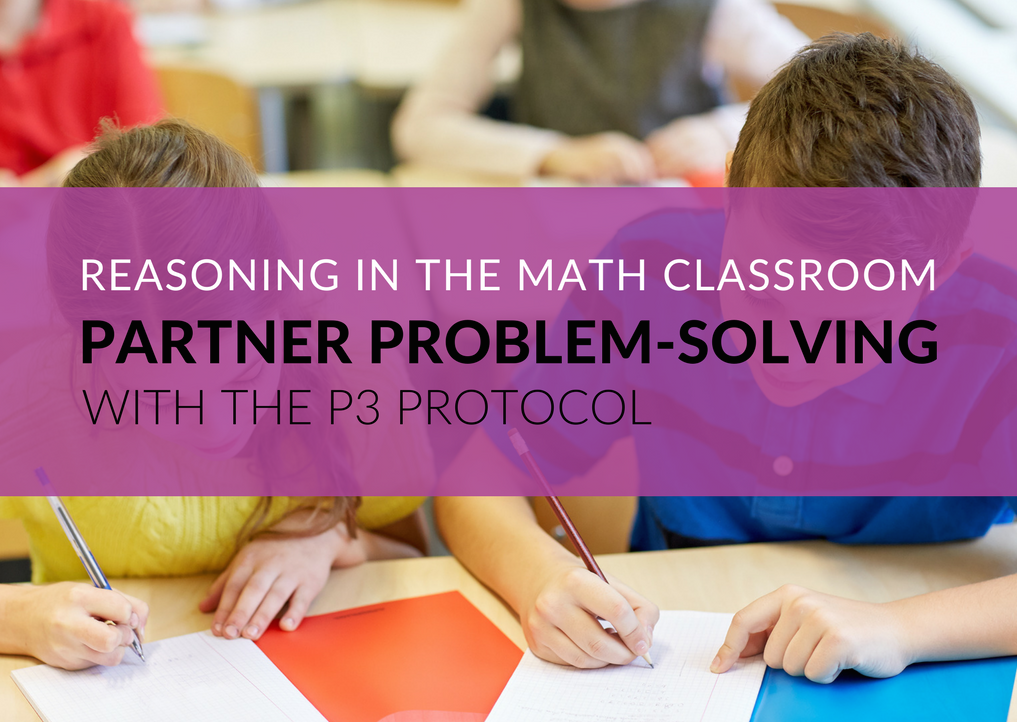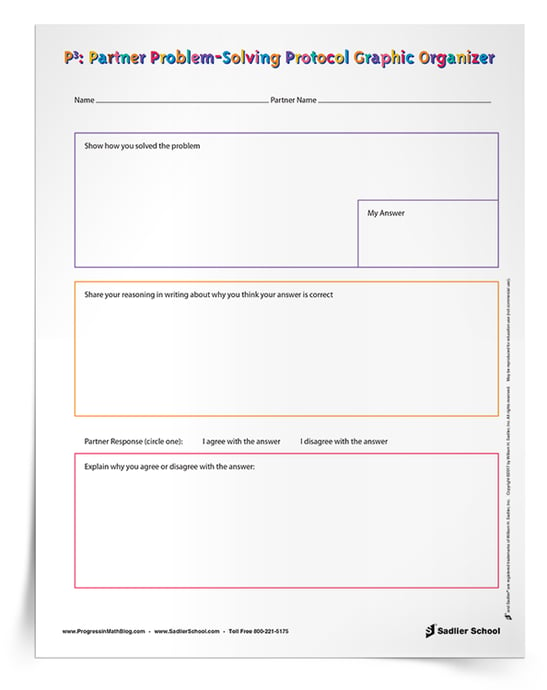June 14, 2017 6-8-math-practices, mp-reasoning, mp-problem-solving, mp-repeated-reasoning, 3-5-math-practices
P3: Partner Problem-Solving Protocol and Graphic Organizer
By: Jeff Todd
In this era of increased demands on student reasoning in mathematics, I have been thinking about how to incorporate more student reasoning into my classroom. I came up with the P3: Partner Problem-Solving Protocol and Graphic Organizer.
This protocol is great because it can be used at almost any grade level, with virtually any math topic. All you need is a set, or a couple of sets, of math problems to solve! You can download the graphic organizer for your students and use it today.

Standard for Mathematical Practice 3 is “Construct viable arguments and critique the reasoning of others.”
In the beginning of the school year, I might model this with the whole class to be sure that they understand what I am looking for when they critique each other. However, a class discussion is not an efficient mechanism for all students to participate in the process of critiquing each other. The whole class discussion only allows for one student at a time to respond.
The P3 Graphic Organizer is one way to address this inefficiency.
PROBLEM-SOLVING PROTOCOL WITH MATH PARTNERS
Students work with a partner to solve math problems, explain their reasoning, and critique the reasoning of their partner. That way, every student takes an active role in the classroom rather than just listening to a class discussion.
Make no mistake, the class discussion is an important format, but using this math partners activity will improve student engagement and provide you with evidence of their ability to reason and critique.
STEPS FOR THE PROTOCOL:
-
Arrange students in pairs. At the end of this post, you will find ideas for helping your students form pairs.
-
Give the students a set of problems to work on. I would suggest at least six problems. Assign one student to the even-numbered problems, and the other to the odd-numbered problems.
-
Both students use the P3 Graphic Organizer independently in order to solve the first and second problems.
-
Each student must commit to the answer and write it on the organizer.
-
After solving a problem, the student writes a convincing argument for why he or she is sure the answer is correct.
-
The partners then exchange graphic organizers. The students review their partner’s problem and reasoning, and indicate whether they agree with the answer or not.
-
Each partner then explains in writing why they agree or disagree with the answer.
-
After they have shared their responses with each other, students can move onto the next pair of problems, using a fresh graphic organizer.
TIPS FOR PAIRING MATH PARTNERS
Here are a few tips for you to keep in mind when you use the Partner Problem-Solving Protocol and Graphic Organizer.
Consider carefully how you want to partner your students. I find the best way to do this is to partner similarly-skilled students.
I don’t usually put my strongest students with my weakest students. This tends frustrate both students, especially if it is a regular classroom practice. An additional benefit of in-class ability grouping is your ability to differentiate the work you give to your students.
-
Sometimes I will sort my students into three groups: those at a beginning level, at a developing level, or at a proficient level. I then partner the students within their groups. That way, I can prepare three different problem sets targeted at each group. Everybody is working on the same types of problems, although at different levels.
-
At other times, I partner weaker students with moderately strong students, and partner my strongest students with each other. I tend to do this more in the later part of a unit—at the point when more than two-thirds the class is achieving the unit goals, but a few students need some extra help. This gives more practice for the students who are just reaching proficiency and more help for those who are still in the developing phase of understanding. At the same time, it pushes those who have mastered the material to work on more challenging problems.
ADDITIONAL USES FOR THE GRAPHIC ORGANIZER
Finally, I’d encourage you to consider using this protocol for geometry or data analysis problems as well. “Math problem solving” is not simply about numbers and algebra.
My printable graphic organizer is designed with enough space that a simple geometry or data analysis problem will fit in the boxes.
This is the kind of activity you can print out today and use right away in your class!




